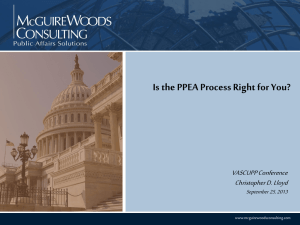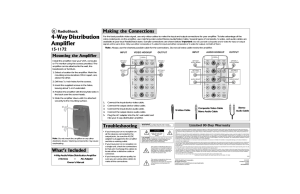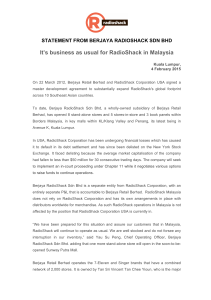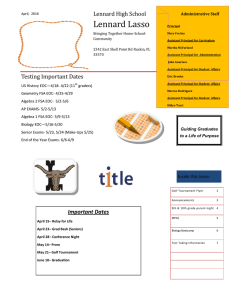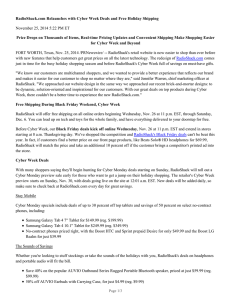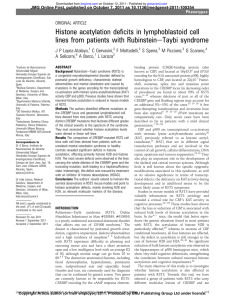Sarbanes-Oxley Background 6/13/2013 What does it mean for IT in the Working
advertisement
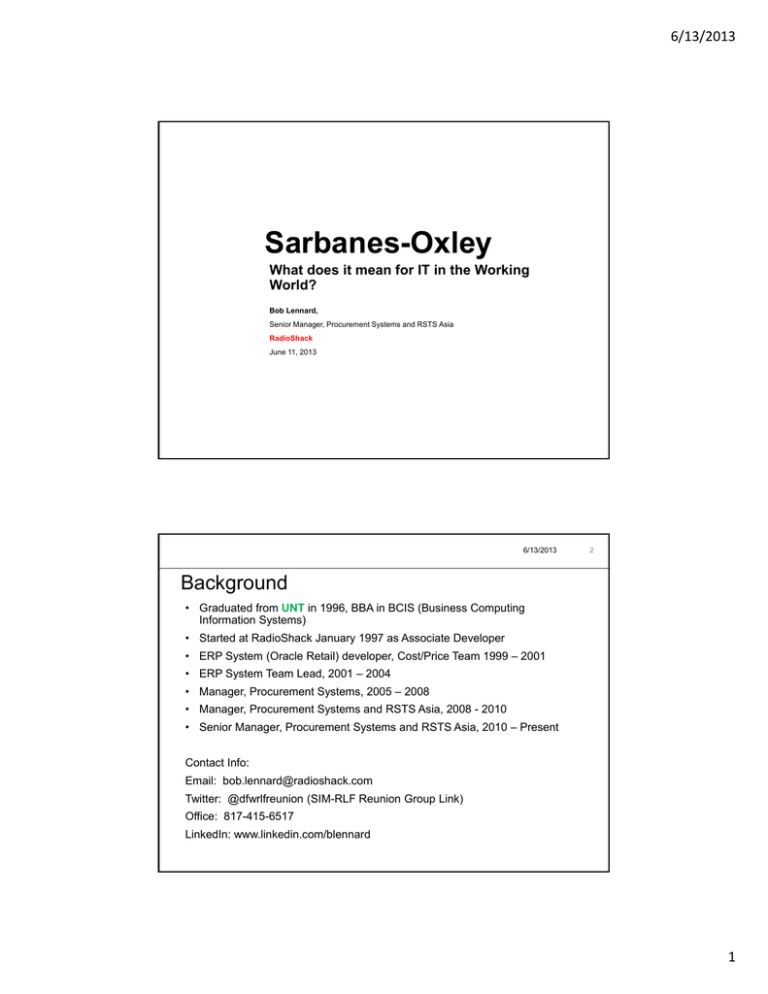
6/13/2013 Sarbanes-Oxley What does it mean for IT in the Working World? Bob Lennard, Senior Manager, Procurement Systems and RSTS Asia RadioShack June 11, 2013 6/13/2013 2 Background • Graduated from UNT in 1996, BBA in BCIS (Business Computing Information Systems) • Started at RadioShack January 1997 as Associate Developer • ERP System (Oracle Retail) developer, Cost/Price Team 1999 – 2001 • ERP System Team Lead, 2001 – 2004 • Manager, Procurement Systems, 2005 – 2008 • Manager, Procurement Systems and RSTS Asia, 2008 - 2010 • Senior Manager, Procurement Systems and RSTS Asia, 2010 – Present Contact Info: Email: bob.lennard@radioshack.com Twitter: @dfwrlfreunion (SIM-RLF Reunion Group Link) Office: 817-415-6517 LinkedIn: www.linkedin.com/blennard 1 6/13/2013 6/13/2013 3 6/13/2013 4 What is Sarbanes-Oxley? Source: EisnerAmper Website: www.eisneramper.com IT Control Objectives What does it mean for IT Management? This requires knowledge of internal controls across business units supported – not just IT controls. Understand what compliance means to your organization – must meet requirements internally and externally. Compliance Planning is a regular exercise Plan Reviews Occur on a Regular Basis Evaluate where system controls are appropriate Integrate IT controls/plans with those of business partners Understand Key Controls, General Controls, and Mitigating Controls IT COSO’s: • Plan & Scope • Perform Risk Assessment • Identify Significant Accounts/Controls • Document Control Design • Evaluate Control Design • Evaluate Operational Effectiveness • Determine Material Weaknesses • Document Results • Build Sustainability 2 6/13/2013 6/13/2013 5 What does it mean to IT and my Job? Impacts: • Time • Competing Efforts • Priority Shifts • Design of Future Applications 6/13/2013 6 Plan and Scope • What Systems? • Which subsystems? • Which business units? • Which IT support team? • Keywords: Financially impacted and General Computing Controls No Planning Results in Significant Creep 3 6/13/2013 6/13/2013 7 Perform Risk Assessment • What is the level of risk? What are the potential impacts of the risk? • How does that weigh against other risks that must be addressed? • Does the risk justify a control? Weighed against cost? • Do you want to create a control for it? • Can this be addressed manually? • Are there mitigating controls that reduce your need to create a new control? 6/13/2013 8 Identify Significant Accounts/Controls • Who/what is the community impacted? What financial area is impacted? • What portion of your business? Percentage? Dollars? • Are there controls in place in other areas that reduce your need for a control here? • Who will be your decision makers in the creation of controls? • Who will be the business owner of this control? The IT owner? 4 6/13/2013 6/13/2013 9 6/13/2013 10 Document Control Design • Decide on Control Type • Design Implementation Strategy • Review Control with Involved Team • Revise Control as Needed • Create Final Documentation Evaluate Control Design • Is control effective? • How does end result compare to documented control? • Are there any issues with existing control? • Does it provide standalone effectiveness? Or is it dependent on another control? • Can it be improved? 5 6/13/2013 6/13/2013 11 Evaluate Operational Effectiveness • Is it feasible to maintain? • Can it even be done? • How many hours of productivity are lost to the control? • Is the control contrary to what the business wants to achieve? • Does this control create any barriers to the overall success of the company? • If there are barriers, how do you meet the need of the control while revamping it to provide operational effectiveness? 6/13/2013 12 Determine Material Weaknesses • Did this address the issue you intended? • Are there any “holes” in your design that allow it to be circumvented? • Are there issues in the process flow tied to this control? • Are there upstream controls that are not providing the feed/information you need? • Are you providing the correct data to the downstream controls? 6 6/13/2013 6/13/2013 13 6/13/2013 14 Document Results • Recurring Process • Validate Results vs. Expectations as Documented in Narrative • Not only results, but often times the related code and processes • May need to present change tracking as well • Company Portal/Cloud Based Options for Documenting • May do more than once – internally and externally Build Sustainability • Identify Potential Improvements • Evaluate against any system changes since last testing period • Identify new systems that require new controls • Review system narratives and control documentation periodically • Work with internal and external audit teams to determine required changes year over year • Words of Caution: • Auditors aren’t going to tell you what to do – just whether the control is valid or not. • Don’t overbuild your controls. You’ll be living with it years after implementation! 7
